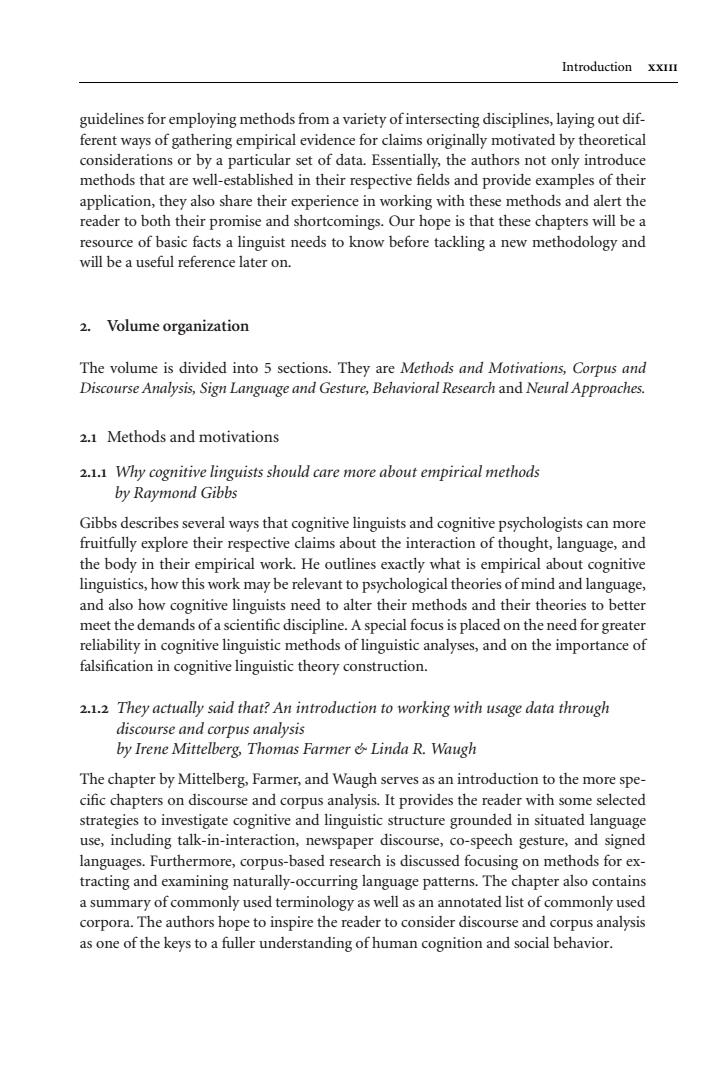正在加载图片...

Introduction xxII guidelines for employing methods from a variety of intersecting disciplines,laying out dif- ferent ways of gathering empirical evidence for claims originally motivated by theoretical considerations or by a particular set of data.Essentially,the authors not only introduce methods that are well-established in their respective fields and provide examples of their application,they also share their experience in working with these methods and alert the reader to both their promise and shortcomings.Our hope is that these chapters will be a resource of basic facts a linguist needs to know before tackling a new methodology and will be a useful reference later on. 2.Volume organization The volume is divided into 5 sections.They are Methods and Motivations,Corpus and Discourse Analysis,Sign Language and Gesture,Behavioral Research and Neural Approaches. 2.1 Methods and motivations 2.1.1 Why cognitive linguists should care more about empirical methods by Raymond Gibbs Gibbs describes several ways that cognitive linguists and cognitive psychologists can more fruitfully explore their respective claims about the interaction of thought,language,and the body in their empirical work.He outlines exactly what is empirical about cognitive linguistics,how this work may be relevant to psychological theories of mind and language, and also how cognitive linguists need to alter their methods and their theories to better meet the demands of a scientific discipline.A special focus is placed on the need for greater reliability in cognitive linguistic methods of linguistic analyses,and on the importance of falsification in cognitive linguistic theory construction. 2.1.2 They actually said that?An introduction to working with usage data through discourse and corpus analysis by Irene Mittelberg,Thomas Farmer Linda R.Waugh The chapter by Mittelberg,Farmer,and Waugh serves as an introduction to the more spe- cific chapters on discourse and corpus analysis.It provides the reader with some selected strategies to investigate cognitive and linguistic structure grounded in situated language use,including talk-in-interaction,newspaper discourse,co-speech gesture,and signed languages.Furthermore,corpus-based research is discussed focusing on methods for ex- tracting and examining naturally-occurring language patterns.The chapter also contains a summary of commonly used terminology as well as an annotated list of commonly used corpora.The authors hope to inspire the reader to consider discourse and corpus analysis as one of the keys to a fuller understanding of human cognition and social behavior.JB[v.20020404] Prn:12/04/2007; 9:53 F: HCP18IN.tex / p.2 (122-187) Introduction guidelines for employing methods from a variety of intersecting disciplines, laying out different ways of gathering empirical evidence for claims originally motivated by theoretical considerations or by a particular set of data. Essentially, the authors not only introduce methods that are well-established in their respective fields and provide examples of their application, they also share their experience in working with these methods and alert the reader to both their promise and shortcomings. Our hope is that these chapters will be a resource of basic facts a linguist needs to know before tackling a new methodology and will be a useful reference later on. . Volume organization The volume is divided into 5 sections. They are Methods and Motivations, Corpus and Discourse Analysis, Sign Language and Gesture, Behavioral Research and Neural Approaches. . Methods and motivations .. Why cognitive linguists should care more about empirical methods by Raymond Gibbs Gibbs describes several ways that cognitive linguists and cognitive psychologists can more fruitfully explore their respective claims about the interaction of thought, language, and the body in their empirical work. He outlines exactly what is empirical about cognitive linguistics, how this work may be relevant to psychological theories of mind and language, and also how cognitive linguists need to alter their methods and their theories to better meet the demands of a scientific discipline. A special focus is placed on the need for greater reliability in cognitive linguistic methods of linguistic analyses, and on the importance of falsification in cognitive linguistic theory construction. .. They actually said that? An introduction to working with usage data through discourse and corpus analysis by Irene Mittelberg, Thomas Farmer & Linda R. Waugh The chapter by Mittelberg, Farmer, and Waugh serves as an introduction to the more specific chapters on discourse and corpus analysis. It provides the reader with some selected strategies to investigate cognitive and linguistic structure grounded in situated language use, including talk-in-interaction, newspaper discourse, co-speech gesture, and signed languages. Furthermore, corpus-based research is discussed focusing on methods for extracting and examining naturally-occurring language patterns. The chapter also contains a summary of commonly used terminology as well as an annotated list of commonly used corpora. The authors hope to inspire the reader to consider discourse and corpus analysis as one of the keys to a fuller understanding of human cognition and social behavior